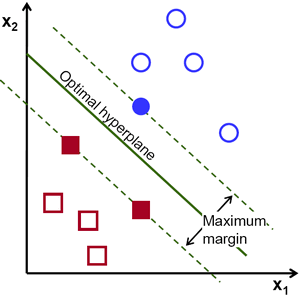
Support Vector Machines (SVMs) are a powerful machine learning algorithm used for both classification and regression tasks. They work by finding a hyperplane that separates two classes of data with maximum margin. SVMs are widely used in a variety of applications, from image classification to financial forecasting.
How SVMs Work?
The goal of an SVM is to find a hyperplane that separates two classes of data with maximum margin. The margin is the distance between the hyperplane and the closest data points from each class. The SVM algorithm aims to find the hyperplane that has the largest margin between the two classes, which results in better generalization to new data points.
If the data is not linearly separable, SVMs can use a kernel trick to map the data into a higher-dimensional space where the classes are linearly separable. The most commonly used kernel functions are linear, polynomial, and radial basis function (RBF).
Applications of SVMs
SVMs are widely used in a variety of applications due to their accuracy and ability to handle large datasets. Here are some examples of how SVMs are used in different fields:
Image Classification: SVMs are widely used for image classification tasks. They can be used to classify images into different categories based on their visual features.
Text Classification: SVMs can be used for text classification tasks such as sentiment analysis. They can be used to classify text into different categories based on the words used in the text.
Financial Forecasting: SVMs are used in finance to predict stock prices and market trends. They can be used to analyze financial data and identify trends that can help investors make informed decisions.
Medical Diagnosis: SVMs are used in medical diagnosis to predict the likelihood of a disease based on patient data. They can be used to identify patterns in medical data that can help doctors make accurate diagnoses.
Natural Language Processing: SVMs are used in natural language processing tasks such as named entity recognition and part-of-speech tagging. They can be used to analyze text and identify specific entities or parts of speech.
Code Example
Here is an example code for SVMs using Python:
from sklearn import datasets
from sklearn import svm
# Load the iris dataset
iris = datasets.load_iris()
# Split the dataset into training and testing data
X_train = iris.data[:-20]
y_train = iris.target[:-20]
X_test = iris.data[-20:]
y_test = iris.target[-20:]
# Create an SVM model with a linear kernel
clf = svm.SVC(kernel='linear')
# Train the SVM model on the training data
clf.fit(X_train, y_train)
# Predict the classes of the testing data
y_pred = clf.predict(X_test)
# Print the accuracy of the SVM model
print("Accuracy:", clf.score(X_test, y_test))
In this code, we first load the iris dataset and split it into training and testing data. We then create an SVM model with a linear kernel and train the model on the training data.
We then predict the classes of the testing data using the predict method and print the accuracy of the SVM model using the score method.
Conclusion
Overall, SVMs are a powerful machine learning algorithm that can be used for a variety of applications, from image classification to financial forecasting. With the ability to handle large datasets and nonlinearly separable data, SVMs are a popular choice for many machine learning tasks.